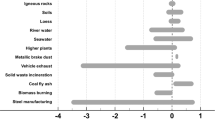Abstract
The speciation of the elements on the surface of the particles collected during dust storm and non-dust storm in Beijing and Inner Mongolia was studied by XPS. The major species of iron on the surface were oxides, sulfate, silicate, FeOOH and minor part sorbed on SiO2/Al2O3. Sulfate is the dominant species of sulfur on the surface. SiO2 and Al2O3 are the main components of Si and Al on the surface respectively. One of the most important findings was that the Fe(II) (FeS and FeSO4) produced could account for up to 44.3% and 45.6% of the total Fe on the surface in the aerosol sample collected at that night and next day of the “peak” time of the dust storm occurring on March 20, 2002, while Fe2(SO4)3, one of the Fe(III) species on the surface decreased from 67.1% to 49.5% and 48.0% respectively. Both S and Fe enriched on the surface of aerosol particles. Fe(II) accounted for 1.3%–5.3% of total Fe in bulk aerosol samples during dust storm. These results provided strong evidence to support the hypothesis of the coupling between iron and sulfur in aerosols during the long-range transport, which would have important impact on the global biogeochemical cycle.
Similar content being viewed by others
References
Zhuang, G., Great change-Dust storm in China, aerosol and global biogeochemical cycle, Science Chinese (in Chinese), 2003, 6: 38–42.
Zhuang, G., Huang, R., Wang, M. et al., The great progress in aerosol study and their impact on the global environment, Natural Science Progress, 2002, 12(6): 407–413.
Iwasaka, Y., Yamato, M., Imasu, R. et al., Transport of Asian dust (KOSA) particles—Importance of weak KOSA events on the geochemical cycle of soil particles, Tellus, 1988, 40B: 494–503.
Duce, R. A., Unni, C. K., Ray, B. J. et al., Long-range atmospheric transport of soil dust from Asia to the tropical North Pacific: Temporal variability, Science, 1980, 209: 1522–1524.
Zhang, X. Y., Arimoto, R., An, Z. S., Dust emission from Chinese desert sources linked to variations in atmospheric circulation, Journal of Geophysical Research, 1997, 102: 28041–28047.
Zhang, X. Y., Gong, S. L., Shen, Z. X. et al., Characterization of soil dust aerosol in China and its transport and distribution during 2001 ACE-Asia: 1. Network observations, Journal of Geophysical Research [Atmos.], 2003, 108(D9): ACH 3/1-ACH 3/13.
Zhang, X. Y., Gong, S. L., Arimoto, R. et al., Characterization and temporal variation of Asian dust aerosol from a site in the northern Chinese deserts, Journal of Atmospheric Chemistry, 2003, 44(3): 241–257.
Fang, M., Zheng, M., Wang, F. et al., The long-range transport of aerosols from northern China to Hong Kong—A multi-technique study, Atmospheric Environment, 1999, 33(11): 1803–1817.
Liu, C. L., Zhang, J., Shen, Z. B., Spatial and temporal variability of trace metals in aerosol from the desert region of China and the Yellow Sea, Journal of Geophysical Research [Atmos.], 2002, 107(D14): ACH 17/1-ACH 17/17.
Tsuang, B. J., Lee, C. T., Cheng, M. T. et al., Quantification on the source/receptor relationship of primary pollutants and secondary aerosols by a Gaussian plume trajectory model: Part III-Asian dust-storm periods, Atmospheric Environment, 2003, 37(28): 4007–4017.
Uematsu, M., Yoshikawa, A., Muraki, H., Transport of mineral and anthropogenic aerosols during a Kosa event over East Asia, Journal of Geophysical Research [Atmos.], 2002, 107(D7 & D8): AAC 3/1-AAC 3/7.
Zhou, X., Xu, X., Yan, P. et al., The kinetics characteristics of dust storm in 2000, Science in China, Ser. D, 2002, 45(10): 911–930.
Zhuang, G., Guo, J. H., Yuan, H. et al., The compositions, sources, and size distribution of the dust storm from China in spring of 2000 and its impact on the global environment, Chinese Science Bulletin, 2001, 46(1): 895–901.
Sun, Y., Zhuang, G., Yuan, H. et al., The characteristics and composition of super dust storm in Beijing, 2002, Chinese Science Bulletin, 2004, 49(8): 698–705.
Guo, J., Rahn, K. A., Zhuang, G., A mechanism for the increase of pollution elements in dust storms in Beijing, Atmospheric Environment, 2004, 38(6): 855–862.
Zhuang, G., Guo, J., Yuan, H. et al., Coupling and feedback between iron and sulphur in air-sea exchange, Chinese Science Bulletin, 2003, 48(11): 1080–1086.
Zhuang, G., Yi, Z., Duce, R. A. et al., Link between iron and sulfur suggested by the detection of Fe (II) in remote marine aerosols, Nature, 1992, 355: 537–539.
Hua, Z., Luo, W., Surface Analysis, Shanghai: Fudan University Press, 1989.
Zhu, Y., Olson, N., Beebe, J. R., Surface chemical characterization of 2.5-μm particulates (PM2.5) from air pollution in Salt Lake City using TOF-SIMS, XPS, and FTIR, Environ. Sci. Technol., 2001, 35: 3113–3121.
Xiao, T., Liu, W., Wang, H. et al., Analysis of the characteristic of particles from different sources in Jinan, Environmental Chemistry, 1998, 17(6): 582–587.
Boudevilie, Y., Figueras, F., Forissier, M. et al., Correlations between X-ray photoelectron spectroscopy data and catalytic properties in selective oxidation on Sb-Sn-Ocatalysts, J. Catal., 1979, 58: 52–60.
Yuan, H., Wang, Y., Zhuang, G., The simultaneous determination of organic acid, MSA with inorganic anions in aerosol and rainwater by ion chromatography, Journal of Instrumental Analysis, 2003, 6: 12–16.
Yi, Z., Zhuang, G., Brown, P. R. et al., High-performance liquid Chromatographic method for the determination of ultratrace amounts of iron (II) in aerosols, rainwater, and seawater, Anal. Chem., 1992, 64(22): 2826–2830.
Wagner, C. D., Riggs, W. M., Davis, L. E. et al., Handbook of X-ray Photoelectron Spectroscopy (ed. Chastain, J.), Norwalk: Perkin-Elmer Corporation, Physical Electronics Division, 1992.
Talor, S. R., McLennan, S. M., The Continental Crust: Its Composition and Evolution, New York: Oxford, 1985.
Zhuang, G., Yi, Z., Duce, R. A. et al., Chemistry of iron in marine aerosols, Global Biogeochem. Cycles, 1992, 6(2): 161–173.
Author information
Authors and Affiliations
Corresponding author
About this article
Cite this article
Zhang, X., Zhuang, G., Chen, J. et al. Speciation of the elements and compositions on the surfaces of dust storm particles: The evidence for the coupling of iron with sulfur in aerosol during the long-range transport. Chin.Sci.Bull. 50, 738–744 (2005). https://doi.org/10.1007/BF03183671
Received:
Accepted:
Issue Date:
DOI: https://doi.org/10.1007/BF03183671




